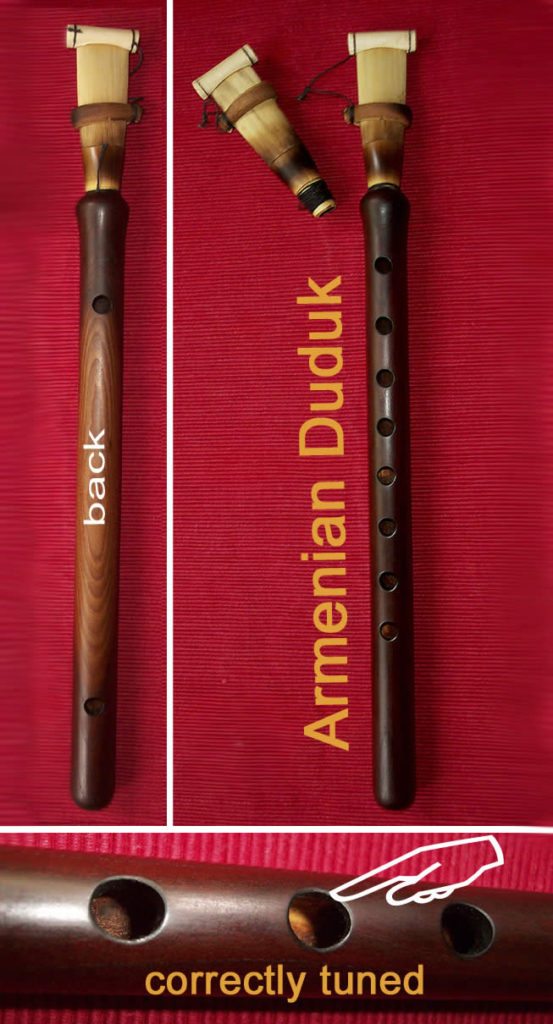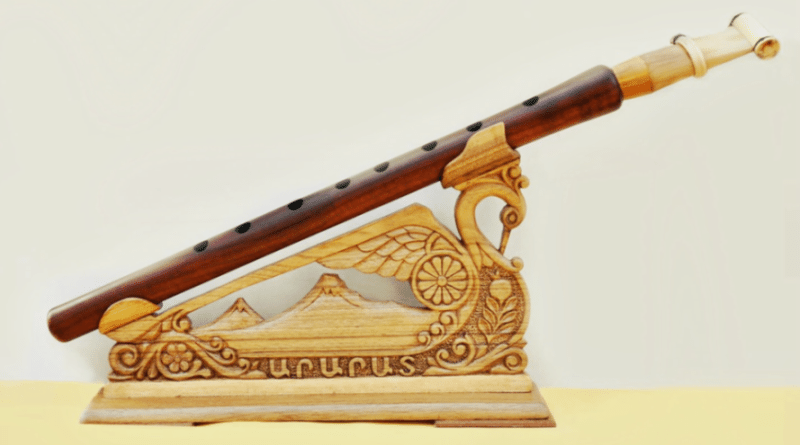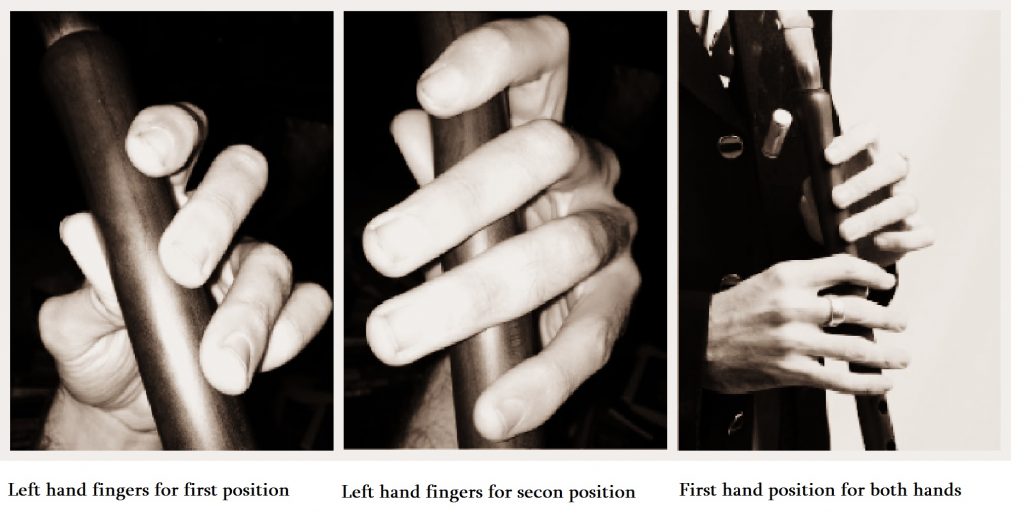“The Duduk is the only instrument that makes me cry” – Aram Khachaturian
The duduk is an Armenian instrument. It is a symbol of Armenian national identity as it expresses Armenian soul, its history, the language, and mood. The word “duduk” means whistle. It is an ancient Armenian musical instrument that originated 5 centuries ago. Musicologists found the most compelling evidence. They found duduk’s use as early as 1200 BC. One can see variants of an Armenian instrument in Persia Georgia, Turkey, Azerbaijan, and Balkans.
Centuries ago people made it from bone or entirely of the cane. Nowadays they made Duduk from wood with a large double reed. Armenians made Duduk’s body from aged apricot wood. The body of Duduk has different lengths. It depends upon the range of the instrument and region. Armenians called Duduk players dudukahar. Dudukahar uses air stored in his cheeks while playing the instrument.
People play Duduk in pairs, with the second dum duduk. Thus it gives tonic atmosphere. Duduk has a contemplative and melancholic sound. It enchants people with its smooth sounds. In fact, Duduk expresses sadness and joy simultaneously. Armenians play it both in funerals and happy public events. You can hear Duduk’s sound nearly in every Armenian folk ensemble in combination with other instruments like Kanun, Kamancheh, and Dhol. Here Duduk loses its melancholy and gains lightness.
Playing the Duduk
While playing Duduk you should not curl your lips over the teeth. ‘In fact, you must not move your lips inwards at all. This instrument must be placed at a slight 40-degree angle. remember that your cheeks must be puffed out. For playing it you must be calm and have a good breath. During playing do not bow your head as this will prevent your breath.
The Duduk is comprised of two main parts: The Barrel and more importantly the Reed as it is responsible for the sound of the instrument. The large Double Reed that connects to the barrel creates the resonance and the sound. The body is traditionally made from Apricot Wood. It is aged and dried accordingly, for higher quality instruments, usually 6 years, and for cheaper or lower level instruments, 2 years. The Duduk in the past was tuned differently. Nowadays Duduks are tuned to a western scale: The Major Scale.
The Duduk Family
Like the majority of wind instruments, the Duduk has a ”family”. In the family, there are all sizes which in effect are their actual pitch/range. Effectively speaking, there exist Duduks to cover Tenor, Soprano, Alto, and Piccolo, as well as Bass/Baritone ranges. The assigning of the Duduks to these ranges is debatable.
– The Duduk in A is the most common. Armenian music is primarily written in this key/mode.
-The Bb Duduk is also common. But it is often most used for playing more “Easter” sounding pieces.
-The Duduk in C is also common since it’s tuned to the C Major scale. Most Western melodies and “simple” music tend to be in this key.
-The Duduk in G has become popular since Levon Minassian tends to favor playing on this Duduk. It has hauntingly deep and rich tone. It is tuned to a G Major scale, making it also favorable for playing some Eastern Scales.
Other types
Less commonly are the higher ranged Duduks, which start from D and go all the way up to F. These tend to be very small, and have a very high pitched sound, something which is not traditionally associated with the Duduk, and perhaps a more eastern sound like the Ney.
Finally, there is the Bass Duduk, which although is sometimes used low dam notes under improvisations. It can also be found in Duduk Quarters, and also being used as a solo instrument. The bass Duduk looks slightly different in design to a regular Duduk. It consists of two to three separate pieces that attach together to form the instrument.
Beyond these Duduks, there are some “modified” Duduks, such as the “Clar Duk”, and Georgy Minnasovs own designed extended range Duduks. These Duduks employ levers and fingers pads like a Clarinet to extend the lower and the upper registers of the Duduk, something which most Duduk players do not favor. The mixing of an ancient instrument with modern levers attached somewhat diminishes the traditional aspect of the instrument. If people want an extended range they can just play on Oboe or an actual Clarinet.
The Ghamish
The “Ghamish” is the native word for the reed in Armenia. The double reed of the Duduk is one of the largest in the world and is directly responsible for the tone and intonation along with the barrel. There are different kinds of reeds: soft, medium, hard and the “plant species” determine the timbre of the tone produced. Thinner or softer reeds tend to have a more nasal quality to them, often associated with Eastern Music, whilst the thicker heavier reeds tend to have a bigger rounder tone, often associated with a more ”European” sound like that of a Clarinet or Bassoon.
If you are a beginner, you mustn’t start with a heavy reed. You should start with s soft light reed or a medium and develop your cheek muscles and technique. After 2 hours of vigorous practice, you can have the option of moving into heavier reeds. It should be noted that many professional Duduk players prefer the sound of lighter nasal reeds over heavier ones and that the tone of the instrument you desire should be based on how you wish to sound.
You should note that an incorrect sized Reed or a Reed which has not been tuned to your Duduk can create tuning issues, but in most cases with time and patience, these can be remedied.
Preparing The Reed
There is confusion over the reed and how to properly prepare it for practice and or performance. Most reed instruments require that the reed be wetted or moist before playing, to produce a smooth tone and avoid scratchy and uneven timbre. The Duduk is similar, but at the same time different.
Now if it’s a completely new reed, chances are it’s been stored for several days or weeks without moisture, and as such it will not open at all. To open the reed, remove the cap and tuning ring and place a few drops of water inside it from the bottom.
The Process
Literally, only a few drops; no more, then cover the hole with the finger and shake it around, so the moisture will cover the inside evenly. Remove your finger and turn it upside down and let any excess water drop out. Leave the ring and cap off and leave the reed for about 10 minutes. After 10 minutes the reed should have opened slightly. If it hasn’t, blow on the reed, and gently squeeze the sides where the leather strips are.
You should start to hear the squeak of a pitch from the reed, and depend on how hard you squeeze the variation of pitch. As mentioned before, don’t squeeze too hard; the idea is just to open it enough to blow into and produce sound. Do this for 3 minutes, wet the reed tips with your mouth and leave again several days.
By now, the reed should be almost playable. Attach it to the body using the method mentioned before, and try playing the” Tonic” of your Duduk and see if it is in tune. Usually, it will be a little sharp still and require that you still “warm up” the reed by blowing more and adding moisture from your mouth.
Thus after several more minutes of blowing, leave the Duduk to sit for 5- 10 minutes.
Finally, you should find that the reed has opened significantly, so now you must place the tuning ring and cap back on, placing the ring around the Reed, and sliding it down to adjust the aperture (how open the double reed is) checking with a tuner to see if the Tonic is sharp or flat, and move the ring accordingly: tighten if it is flat, loosen if it is sharp.
Buying Duduk or Reed
There are several places where one can purchase professional quality Duduks, assuming you don’t have one already. Avoid eBay and Amazon: these are sometimes souvenir quality instruments designed solely for the purpose of decoration. A list of known dealers and suppliers is listed in the appendix. Here are some of the sources people acquire their Duduks from:
eBay Duduks
Master Simon Duduks
Holding the instrument
When learning to play any instrument, it is important that you learn right, and develop good habits from the get go, hence we need to start with how the instrument is held. This might seem like a trivial detail, but the improper placement of the fingers, and how you hold the instrument can hinder not only the performance of certain pieces but will also hinder your development of the subtle techniques required to make the Duduk sound like the wonderfully diverse and idiosyncratic instrument it is.
Unlike most flutes, the instrument’s holes are covered using not the tips or pads of the hand, but actually the middle part of the finger. This applies to the right hand (assuming you are right handed) that holds the lower three to four holes. The duduk has two hand positions.
First-hand Position
The first is when we are using the range of the instrument from the Tonics lower seventh degree, and the second position is when the entire range of the Duduk will be used, and all four fingers from both hands are employed in covering the finger holes.
Second-hand Position
When using the second-hand position, the left hand’s placement changes, and instead of using the pads of the fingers, we are now using the middle part of the finger, just the same as the right hand. Although this may feel awkward at first, it is actually the best way to be able to use the instruments entire range, whilst having a stable grip of the instrument, and to have full control of your technique whilst doing so.
In fact using finger pads whilst trying to use all four fingers will result in bad control of intonation and you will find that the instrument is not comfortably held in place in your hands. It is common to see amateur or beginner Western players using the finger pads from both hands and is the danger of not having instructional material or a teacher to demonstrate proper technique or pedagogy.













Leave a Comment